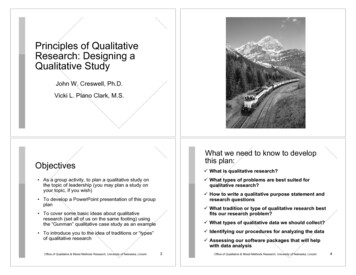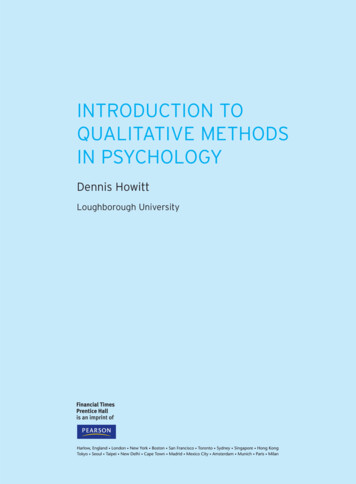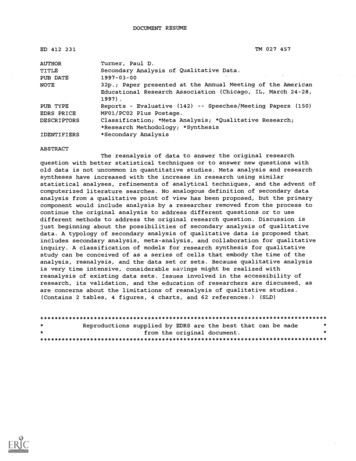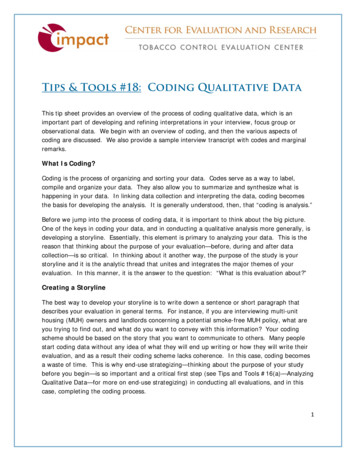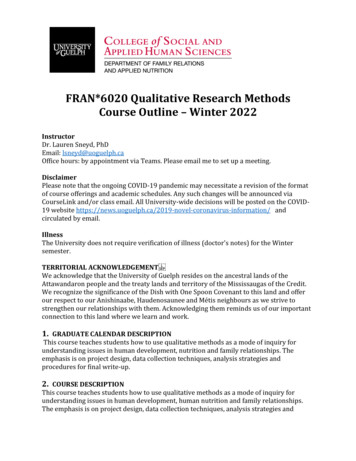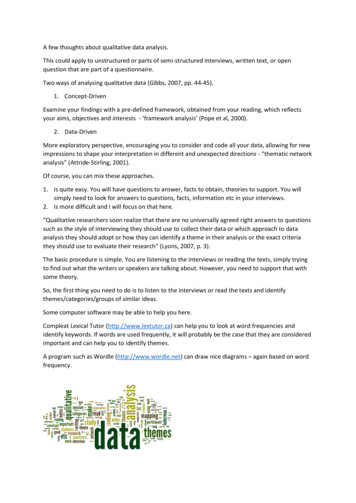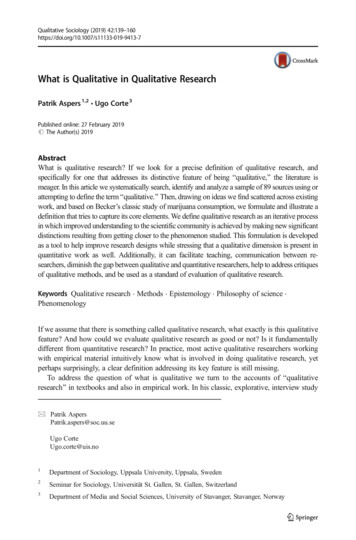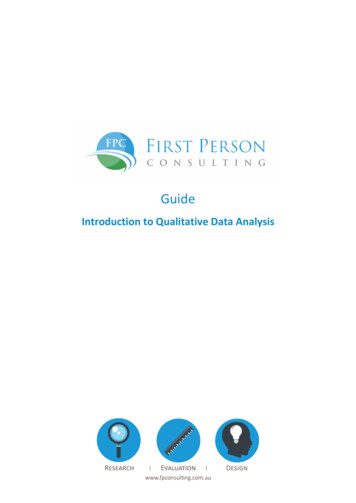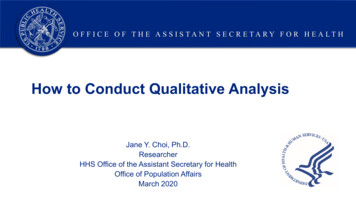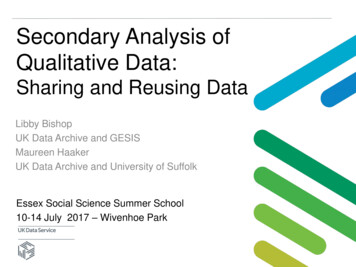
Transcription
Secondary Analysis ofQualitative Data:Sharing and Reusing DataLibby BishopUK Data Archive and GESISMaureen HaakerUK Data Archive and University of SuffolkEssex Social Science Summer School10-14 July 2017 – Wivenhoe Park
Plan for the week Day 1 – Introduction to SAQD Day 2 - Key issues in SAQD Context Ethics Day 3 – Methods Sampling Learning methods from data Day 4 – Data exchange exercise Day 5 – Accessing, using, and sharingdata
Day 1 – Introduction to SAQD Pros and cons of reusing qual dataWhys and ways of reusing qual dataA case study of data reuseHow might you reuse examples ofdata?
Reusing Qual Data – pros and cons Group One: generate reasons for why researchersshould/might want to reuse data.o What are the benefits of reusing data?o Who does sharing data benefit? And how? Group Two: generate reasons for why researchers shouldnot/might not want to reuse data.o What are some of the concerns associated with reusing data?o What are some of the impediments to reusing data? Take about 10 minutes in groups, then we will discuss.
Arguments for sharing and open data Duties to participants –protect and Empower – give voice Avoid burdensome replication Duties to scholarlycommunity Transparency Research integrity Duties to public Use public funds wisely
Why engage in re-use of “old” data? new questions of existingdata methodological study oforiginal research teaching comparative across time across locations cross-sectional subsamples make better use ofpainstakingly collected, rich,extensive data cost/time savings(?)
Qualitative data – challenges for sharing Strong relationships of trust, commitments toconfidentiality Participant identity difficult to conceal Audio and visual data Research locations potentially identifiable Difficult to anonymise data without reducing researchvalue Research may investigate illegal activities But potential benefits of data sharing make it imperativeto face these challenges
“But no one reuses qualitative data ”Health and Social Consequences of the Foot and MouthDisease Epidemic in North Cumbria, 2001-2003 (SN5407) secondary analysis to study families and food; policy briefing of the economic cost of animal healthdiseases with aim of considering how UK may be betterprepared to deal with outbreaks like this; use transcripts from previous focus groups with farmers tostudy biosecurity on dairy farms in the UK; the data will be used as teaching material for medicalstudents for interview skills; building a speech recognition engine to automaticallytranscribe interviews for qualitative research.
Research - reusers’ commentsHow Britain Dies is a research project run by the think tankDemos and funded by Help the Hospices. One focus of ourwork is to look at the views of dying people and their familiesaround what makes a good death and where people aredissatisfied with how they and their loved ones die.I am interested in accessing Oral Interviews to analyse theresponses of psychiatric nurses to changes in their profession I believe they will give me an unrivalled opportunity to bring thevoice of the nurse to the foreground.This data will be used to pilot test an innovative method forqualitative data analysis using crowd sourcing technology.
Who would re-use data? Mike Savage (York) Class and class identity Jane Elliott (soon to be at Exeter) On being a good mother Dawn Lyon (Kent) and Graham Crow (Soton) Revisiting Ray Pahl’s Sheppey studies Jo Haynes (Bristol) Reusing data for PG methods teaching Julia Brannan (IoE) Food and meal practicesESRC Secondary Data Analysis Initiative – Phase 3
Re-use purposes of qualitative datadownloaded from UK Data Service, 2002-2016
Examples of re-using “old” data assess the credibility of new research or the generalizability of small studies(Hammersley 1997) supplement one’s own primary data, e.g. as exploratory analyses prior to newdata collection (Hinds et al. 1997) provide rich descriptive information, e.g. an historical perspective (Bornat 2005,Gillies & Edwards 2005) reveal new methodological insights (Mauthner et al 1998, Savage 2005; Bornat2010) generate new findings by analysing ‘old’ data from a ‘new’ research context(Holland & Thomson 2009; Bornat 2010; Walkerdine and Lucey 1989) gain insight on hard to reach populations or sensitive topics without furtherintrusion into vulnerable populations (Fielding & Fielding 2000) teaching (Haynes 2011)(Irwin & Winterton, 2010)
Explosion of qualitative data archives UK Data Service – over 1000 data collections Germany, Finland, France, Switzerland, et al. ARK – N. Ireland - The Troubles Archive Australian Qualitative Data Archive Irish Qualitative Data Archive UCL – Human communication AV archive Timescapes – qual longitudinal data on families Qualitative longitudinal data in Europe – 14 countriesand “analysis of secondaryqualitative data” a recognised methodology by theNational Centre for Research Methods in 2015
Many ways of re-using data Description – literature review with data Research design and methodology Re-analysis – new questions of existingdata When might it be an advantage for the topicfor reuse to NOT be the same as the primaryresearch? Repurposing – e.g. keyword analysis ofillness narratives Learning and teaching
SN 4867: School Leavers StudyPrincipal investigator: Ray PahlIn 1978, teachers at a comprehensiveschool on the Isle of Sheppey wereasked to set an essay about 10 daysbefore pupils were due to leaveschool. The essay asked students toimagine that they were nearing theend of their life, and that somethinghad made them think back to the timewhen they left school. They were thenasked to write an imaginary accountof their life over the next 30 or 40years.
How can the data be used?Living and Working on Sheppey, Dawn Lyon and Graham Crow1. Digitised the original 1978 handwritten data.2. Coded and compared the data across timeTogether, these two sets of essays shed light on the aspirations ofSheppey’s young people (and young people more generally) and covera range of topics including health, education, career, family and leisure.
School Leavers Re-Study:Imagining the FutureRe-users: Graham Crow and Dawn Lyon
Living and Working on Sheppey1978: 141 essays (89 boys and 52 girls)‘Living without a job: how school leavers see the future’ published in NewSociety in 1978 (2 November, pp. 259-62).2009-10: The exercise was repeated by the Living and Working on Sheppeyproject and 110 essays (55 boys and 55 girls) were gathered from schoolpupils and members of youth groups on the Isle of Sheppey to compare tothe earlier ones.Together, these two sets of essays shed light on the aspirations ofSheppey’s young people (and young people more generally) and cover arange of topics including Health Education Career Family and leisure
School Leavers Re-StudyEssay instructions 2010: Imagining the Future:I want you to imagine that you are towards the end of your life. Look back overyour life and say what happened to you. Don't write a very exaggerated story,just tell the straightforward story of your life as it might really be. Of course youcannot know what is going to happen to you, but you can describe the sort ofthing that could happen if things go as you expect or hope. Spread your storyover your whole life from the time of leaving school. Continue on another sheetas necessary.
Living and Working on Sheppeyhttp://www.livingandworkingonsheppey.co.uk/
School Leavers Study: publications Lyon, Dawn, and Graham Crow (2012) ‘The challenges and opportunitiesof re-studying community on Sheppey: young people’s imaginedfutures’, Sociological Review 60: 498-517.Lyon, Dawn, Bethany Morgan, and Graham Crow (2012) ‘Working withmaterial from the Sheppey archive’, International Journal of SocialResearch Methodology 15(4): 301-309.Weddell, Emma, Graham Crow and Dawn Lyon (2012) ‘Imagining theFuture, What can the aspirations of school-leavers in 1978 and 2010 tellus about the changing nature of society?’ Sociology ReviewCrow, G. and N. Takeda (2011) ‘Ray Pahl’s Sociological Career: FiftyYears of Impact’, Sociological Research Online, 16 (3)11: http://www.socresonline.org.uk/16/3/11.htmlCrow, G., Hatton, P., Lyon, D. and Strangleman, T. (2009) ‘New divisionsof labour?: Comparative thoughts on the current recession’, SociologicalResearch Online vol14 issue2/3 http://www.socresonlline.org.uk/14/2/10.html
How could you reuse these data? Seymour, Jane (2017). Managing suffering at the end oflife: A study of continuous deep sedation until death.[Data Collection]. Colchester, Essex: Economic andSocial Research Council. 10.5255/UKDA-SN-850749 Morgan-Brett, B. (2016). Negotiating Midlife: Exploringthe Subjective Experience of Ageing, 2006-2008. [datacollection]. UK Data Service. SN: 8035,http://doi.org/10.5255/UKDA-SN-8035-1
How would you reuse this data?Consider: What was the original question of the research project? What are 2 new questions you might ask of the data?When brainstorming new questions, you might consider thefollowing types of reuse: Re-study Repurpose/re-analysis Description Teaching and learning Methodological advancement Comparative study
Day 2 The Context Debate
Constructing knowledge/reusing dataWhat is distinctive about qualitative research?From this point of view, data cannot be first collected andanalysed and then ‘re-used’ by other researchers for thepurposes of ‘secondary’ analysis. Indeed, data cannot evenbe ‘collected’ in the first place because they are alwaysconstructed, as Bateson (1984) pointed out long ago in thecontext of survey research (Hammersley 2010).
Point of agreement: direct involvement in theoriginal data production offers unique insights“For one thing, in the process of data collection researchersgenerate not only what are written down as data but also implicitunderstandings and memories of what [primary researchers] haveseen, heard, and felt, during the data collection process. Forinstance, not everything that is experienced in the course ofparticipant observation or in-depth interviewing will be or can bewritten down. Nevertheless, it will often be drawn on tacitly, andperhaps sometimes consciously, in the course of analysis, perhapsplaying an important role in making sense of the data that have beenrecorded”Hammersley (2009, para 3:4)But do these insights preclude others from their own substantiveinsights?
The context argument Data do not exist independently of the contexts inwhich they were produced or (co)constructed orgenerated. That context is—by definition—inaccessible tosubsequent researchers. Anyone conducting SA lacks the context known bythe primary researcher(s), “head-notes”. Thus all SA is inevitably limited to providingmethodological, but not substantive, insightsbecause of this lack of contextual information(Mauthner-several).
Limits on the construction of data4.3 However, there is a counter-intuitive quality to thisargument that ought to trouble us. After all, surely we donot and should not make up our data? I take this to be truewhether or not one is a realist or even a ‘latent positivist’(Mauthner et al 1998:736 and 743; Moore 2006:11; Moore2007:3.3), though there are no doubt some who wouldchallenge the point.[5] What this means is that the datamust in some ways constrain what inferences we makeand the conclusions we reach, rather than being freelyconstructed in and through our inferences. And this impliesthat they must, in some sense, exist prior to andindependently of the research process (Hammersley 2010)
“Being there” is not the “be-all and end-all” Depends on primary research design and secondaryresearch questions Ethnography vs. semi-structured interview Content analysis Even primary researchers miss features of context thatlater prove salient Presence/closeness may conceal as well as reveal What primary researcher “knows” is not always right Distance may reveal new understandings “Some forms of interpretation are possible only from a distance”(Mason 2007) Wilson (2014)–youth interviews–proximity & distance
The context debate: response Hammersley (2010): data are both given and constructed Data: that which is collected or generated in the course of research;but cannot be completely constructed. Evidence: the analysed data which provides the grounds for inferenceand for the descriptive and explanatory claims which are built on thedata. There is temporal and conceptual overlap, but evidence is moreconstructed than data (my wording). How does this connect with context again? access to context (‘head notes’) may give primary researcher moreprivileged relationship to some “data as given”, but does NOT imply privileged relationship to “data as evidence”,interpretation (Irwin and Winterton 2011)
Summary of the arguments Primary researchers have more privileged knowledge of, andaccess to, primary data but both primary and secondaryanalysts will construct data as evidence in the service of someempirically grounded set of arguments and knowledge claims. How effectively such arguments are made can be judgedagainst the criteria of social scientific explanatory adequacy.Presence at the point of data generation is not a final arbiter. Overplaying the significance of proximate context relative toother salient factors may risk privileging description overexplanation Theorising and analysing context needs to be part of a criticalsecondary analysis.
“Primary analysts have a privileged relationship to the datathey have generated, but do not necessarily have aprivileged claim on the arguments which can be made fromthat data. Sociological data will support different theoreticalunderstandings, and ‘being there’ is not the final arbiter ofthe adequacy of such understandings”(Irwin and Winterton 2010)
Day 2 The context debate Ethical questions
Ethical questions about data re-use Can consent for unknown futurepurposes be informed? does sufficient anonymisation for reuse damage data quality? does archiving data increase risk ofmisuse?
Participants share their data more than we predict Timescapes data on personal relationships 95% consent rate foot and mouth disease in N. Cumbria sensitive community information UK Data Archive consultation; pilot with 4 participants 40/54 interviews; 42/54 diaries; audio restricted Finnish research on consent (Arja Kuula, IASSIST Quarterly) re-contact project: life stores, gender, etc. 165/169 (98%) agreed even bereaved relatives want others to benefit from their data
Informed consent for unknown future uses It is possible to provide much information aboutreuse who can access the data – only authenticatedresearchers purposes – research or teaching or both confidentiality protections, undertakings of futureusers Medical research and biobank models –enduring, broad, open consent no time limits; no recontact required unspecified hypotheses and procedures 99% consent rate (2500 patients) – Wales CancerBank
Consent, anonymisation, and access Ask for consent to share –researchers must beinformed about risks and benefits of data sharing Anonymise – only if damage to data is minimal (notimages) Regulate access End User Agreement (UK Data Archive) Embargo for selected sensitive or disclosive data – registeredusers; permission from data depositorThese strategies enable most data to be shared
Anonymising qualitative data plan or apply editing at time of transcription except: longitudinal studies (linkages) consistency within research team and throughout project Identify replacements, e.g. with [brackets] keep anonymisation log of all replacements, aggregations or removals made– keep separate from anonymised data files avoid blanking out; use pseudonyms or replacements avoid over-anonymising - removing/aggregating information in text candistort data, make them unusable, unreliable or misleadingControlling access a better option than over-anonymising
Data access spectrum Open Safeguarded End User Licence Special Conditions Online agreementDepositor permissionSpecial Licence Controlled – secure remote access Possibility for multiple versions UK Data Archive - certified for its secure data handlingprocedures under the international ISO 27001 standardfor information security
Risks of mis-use in re-using data Researchers’ reputations (senior and junior) Harms to participants Disclosure of information Their views or opinions misrepresented what if another researcher interprets “my” participants’words differently? Consider argument in light of all kinds of participants:terrorists, paedophiles, Ku Klux Klan, other hate groups Comes back to role of researcher Respect participants, represent their views But not unreflexively, not uncritically, always as part of analyticwork Interpretations must be adjudicated openly, in publications, and(where possible) based on shared data
Who owns the data?“But it’s also the notion of intellectual property, isn’t it? Whoseintellectual property is that stuff there? We say it’s – we put our stampon it, it’s our intellectual property.”“I’m sorry [laughs] I don’t agree with that. I think there’s – I mean I seeresearch as being a public benefit. It’s publicly funded; it’s for publicbenefit. I also see research as being intrusive and demanding of theparticipants and so therefore what the participants record is of valueand I think archiving it, even if it had a 30 year embargo on it, is actuallypaying respect to what people have said and building up a stock of theworld’s knowledge.” (Broom et al. 2009)
Day 3 – sampling and other methods issues Sampling – Jefferys and Bornat asbackground Sampling – Gallwey – read backgroundthen do exercise Other methods – using data to learnmethods wit UK Data Service resources
Fit, lack of fit, and sampling Lack of fit (sample not suited for RQ) It is a problem in much primary research as well But even more so in QSA (e.g., no ability to probe) Some tools for sampling are available, but limited No unified portal for data archives Search possible only of metadata, or at collection level Growing list of exemplary practices Bornat et al. (2012) geriatrics OH interviews Gallwey (2013) single motherhood
Sampling – adding new data to existing One solution – collect new data to match, or fit with whatyou know already exisits Bornat, et al. (2012) Revisiting the archives: a casestudy from the history of geriatric medicine Primary data – Margot Jeffries – origins of geriatrics
Sampling – rationale for 1ary and 2arysamples Jeffreys project – 1991, origins of geriatric medicine Primary Sample 72 people – many roles – politicians, medical civil servants, 54 geriatricians – 18 born before 1914, oldest was 92Qualified at doctors before WW2All but one were white Bornat‘s project – experiance of S Asian doctors andmeaning for geriatrics, her sample. 60 geriatricians from S Asia, worked in England or Wales2/3 entered labour market in 1976 or beforeAll but 5 maleSnowballing used – any issues?S Asian doctors less willing to deposit in British Library-why?
Case Study: Dr April Gallwey
ResourcesReusing qualitative data. sis/reusing-qualitative-dataBishop, L. (2016) Secondary analysis of qualitative data, in D. Silverman (ed.)Qualitative Research.Bishop, L. (2013) 'The value of moral theory for addressing ethical questions whenreusing qualitative data' Methodological Innovations Online (Special Issue onEthical Issues in Using Archived Data) 8(2) wp-content/uploads/2013/12/3.Bishop.pdf.Bishop, L. (2012) 'Using archived qualitative data for teaching: practical and ethicalconsiderations', International Journal of Social Research Methodology, 15(4)[Special Issue: Perspectives on working with archived textual and visual material insocial research], pp.341-350. doi: ve.ac.uk/about/staff?sid ebishopTimescapes Guide 19 – Qualitative Secondary Analysis, Irwin and lysis.pdf
QuestionsLibby Bishopebishop@essex.ac.uk
Day 1 - Introduction to SAQD Pros and cons of reusing qual data Whys and ways of reusing qual data A case study of data reuse How might you reuse examples of data? Reusing Qual Data - pros and cons _ Group One: generate reasons for why researchers should/might want to reuse data. o What are the benefits of reusing data? .
